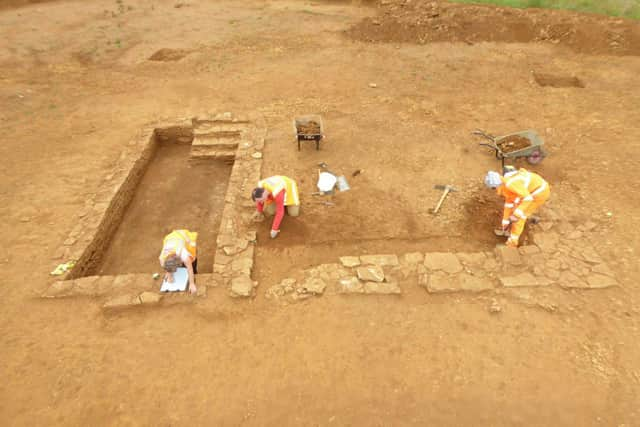'Highly significant' 4,000-year-old centre of ritual activity discovered in rural Northamptonshire
and live on Freeview channel 276
Archaeological excavations in rural Northamptonshire have uncovered an ancient focal point of ritual and religious activity centred around a natural spring.
In use for more than 2,000 years, the site includes a Bronze Age barrow and unusual Roman building, currently interpreted as a shrine.
Advertisement
Hide AdAdvertisement
Hide AdThis fascinating ritual landscape has been revealed by archaeologists from MOLA (Museum of London Archaeology) who excavated on behalf of Taylor Wimpey, Vistry Group and archaeological consultant RPS.


Work took place ahead of new housing development, The Atrium @ Overstone, currently under construction north-east of Northampton.
The earliest archaeological evidence discovered was a Bronze Age barrow – a form of ancient burial mound, built around 2000 BC – 1500 BC.
This feature would have been part of a wider funerary landscape. However, unusually when excavated, archaeologists found that the barrow did not contain any human remains - only five empty burial urns.
Advertisement
Hide AdAdvertisement
Hide AdAs MOLA project manager, Simon Markus, said: “The fact no human remains were placed within the barrow suggests it may have had a more symbolic rather than functional use.
"It seems very likely this landscape was already a highly significant place for local ancient communities, and those pre-existing associations led people in the Bronze Age to pick this site for the construction of a ritual monument.”
During the Roman period (43 AD – 410 AD) the site gained new significance and an unusual stone building was constructed.
Decorated with elaborately painted plasterwork, possibly a painted ceiling, and containing an underground room, it appears to have had no functional use.
Advertisement
Hide AdAdvertisement
Hide AdConsequently, this has been interpreted by archaeologists as a shrine, likely associated with the nearby spring.
Visitors may have left votive offerings, including coins and other artefacts, although none were found during the excavations.
RPS deputy operations director, Simon Mortimer, said: “The developer-funded work undertaken across this site, coupled with other nearby recent excavations, is radically changing our understanding of whole landscapes around Northampton.
"The current residents are part of a long chain of occupation and ownership.”
Advertisement
Hide AdAdvertisement
Hide AdThe spring wasn’t just the focus of worship during the Roman period.
The discovery of large water tanks indicate the spring water was used for processing crops and other industrial activities.
It also provided valuable drinking water and the water remains drinkable to this day.
The bottom of these water tanks provided a final extraordinary discovery - the 2000-year-old organic remains of willow tree blossoms, pinecones, walnut shells, and even a complete leather shoe.
Advertisement
Hide AdAdvertisement
Hide AdVictor Idowu, land and planning director at Taylor Wimpey South Midlands, said: “It has been fascinating to learn what the team has uncovered at the site.
"The findings here are not only important within an archaeological context, but they will now also influence the placemaking of the site.
"As part of the works we will be maintaining the water courses, building upon the ancient significance and symbolism of Overstone.”
Archaeologists are continuing to study and analyse finds from the site, with their focus now turning to the environmental remains, preserved for thousands of years by the sacred spring.
Advertisement
Hide AdAdvertisement
Hide AdThrough this analysis they will build a fuller picture of how this important site was connected to the surrounding landscape.
The Atrium @ Overstone will be a development of 350 contemporary homes ranging from one-bed apartments to five-bedroom detached houses.vice and services for nearly 50 years.